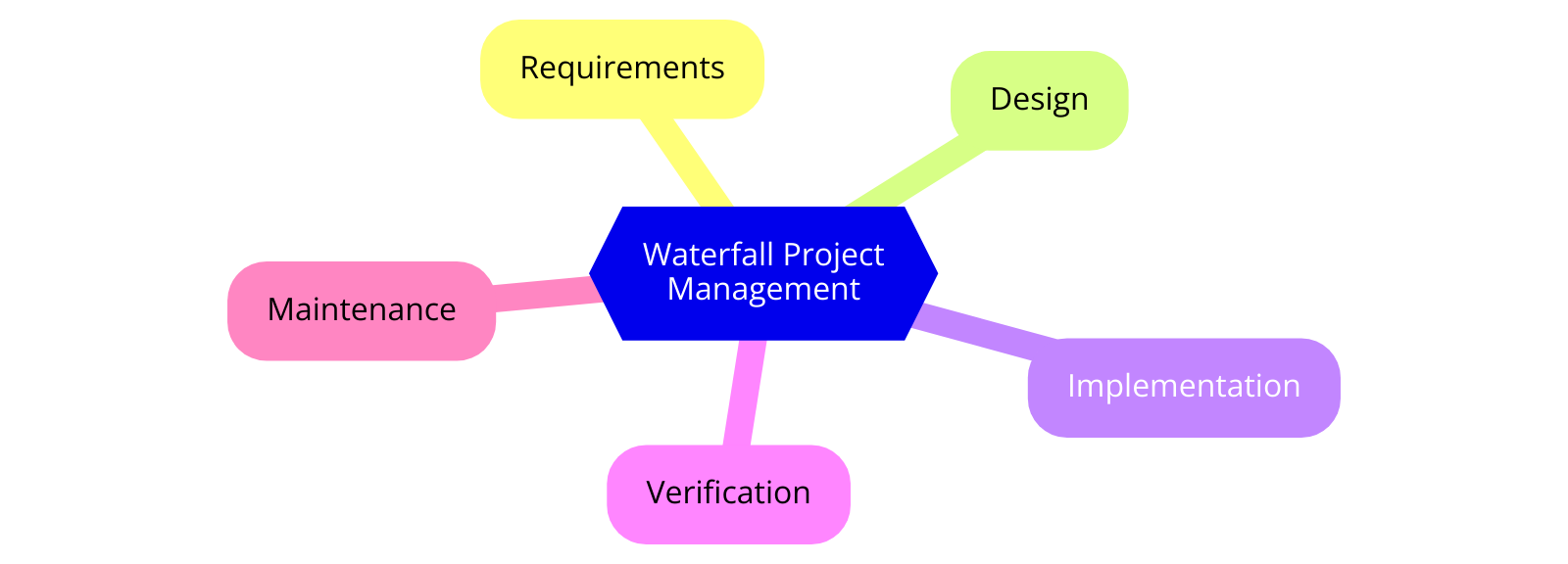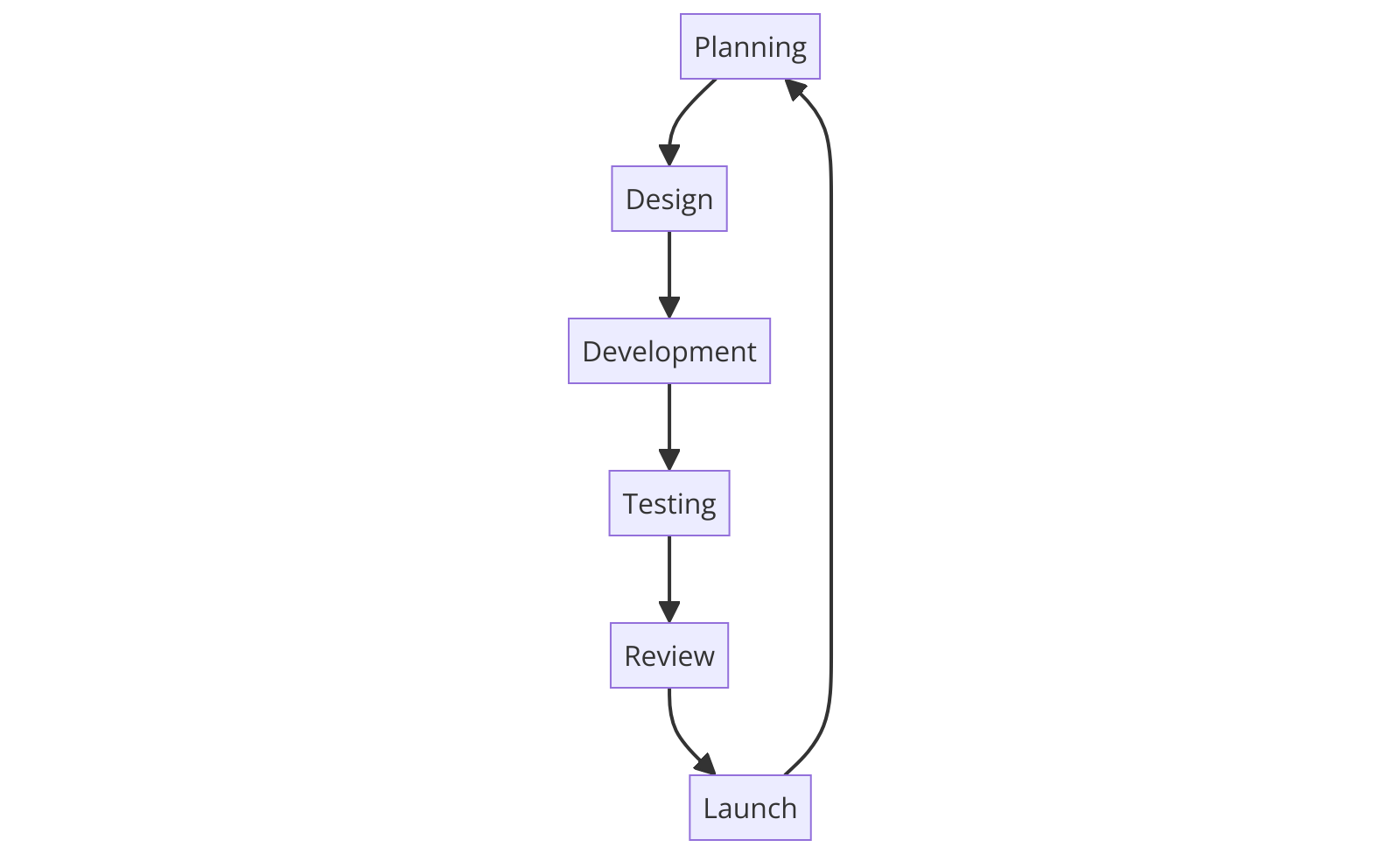Agile vs Waterfall
What is Waterfall Project Management
Waterfall is a traditional project management methodology that follows a linear and sequential approach. It is often referred to as a "plan-driven" methodology because it involves extensive planning and documentation before the project execution begins. The Waterfall model divides the project into distinct phases, each of which must be completed before the next phase begins.
Phases of Waterfall:
- Requirements Analysis: Gathering and documenting all project requirements.
- System Design: Creating detailed designs and specifications based on the requirements.
- Implementation (or Development): Writing the code and building the system according to the design.
- Integration and Testing: Integrating all system components and thoroughly testing them.
- Deployment: Deploying the system to the production environment.
- Maintenance: Providing ongoing support and making necessary updates to the system.
Advantages of Waterfall:
Clear Structure and Phases:
- Waterfall provides a clear, structured approach with defined stages, making it easy to understand and manage.
Detailed Documentation:
- Extensive documentation is created during each phase, which can be useful for future reference and maintenance.
Predictable Outcomes:
- With a well-defined plan, the project’s outcome, timeline, and budget are predictable and controlled.
Easy to Manage:
- The linear nature of Waterfall makes it easier to manage and monitor progress as each phase is completed sequentially.
Disadvantages of Waterfall:
Inflexibility:
- Once a phase is completed, it is difficult to go back and make changes, making it less adaptable to changing requirements.
Delayed Testing:
- Testing is done late in the development cycle, which can result in discovering defects and issues much later, potentially leading to higher costs and delays.
Risk of Requirement Changes:
- Because requirements are gathered at the beginning, any changes later in the project can be costly and time-consuming to implement.
Limited Customer Feedback:
- Customers do not see the product until the final stages, reducing the opportunity for early feedback and adjustment.
What is Agile Project Management?
Agile is a flexible and iterative project management methodology that focuses on delivering small, incremental improvements to the product through short development cycles called iterations or sprints. Agile emphasizes collaboration, customer feedback, and continuous improvement.
Key Principles of Agile:
- Iterative Development: Work is divided into small, manageable chunks called iterations or sprints, usually lasting 2-4 weeks.
- Customer Collaboration: Continuous involvement of customers and stakeholders throughout the development process to gather feedback and adjust priorities.
- Flexibility and Adaptability: Agile teams embrace change and adapt to new information and requirements as the project progresses.
- Self-Organizing Teams: Teams are empowered to organize themselves and make decisions to achieve project goals.
Advantages of Agile:
- Flexibility and Adaptability:
- Agile is highly flexible, allowing teams to respond to changes quickly and efficiently.
Early and Continuous Delivery:
- Products are delivered in small increments, providing early and continuous delivery of value to customers.
Customer Involvement:
- Continuous customer feedback ensures that the product meets user needs and expectations, improving customer satisfaction.
Reduced Risk:
- Frequent testing and feedback loops help identify and address issues early, reducing the risk of major defects and rework.
Improved Team Collaboration:
- Agile fosters a collaborative environment, enhancing communication and teamwork.
Disadvantages of Agile:
- Less Predictable:
- The flexible nature of Agile can make it challenging to predict timelines, costs, and outcomes accurately.
Requires Experienced Teams:
- Agile relies on self-organizing teams that must be skilled and experienced to manage their own work effectively.
Scope Creep:
- The continuous influx of new requirements and changes can lead to scope creep, potentially extending the project duration and increasing costs.
Documentation Might Suffer:
- Agile's focus on working software over comprehensive documentation can sometimes lead to insufficient documentation, making future maintenance difficult.
Comparison: Agile vs. Waterfall
Agile Waterfall 
- Approach
- Agile: Iterative, incremental
- Waterfall: Linear, sequential
- Flexibility
- Agile: Highly flexible, easily adaptable to changes
- Waterfall: Inflexible, changes are difficult and costly
- Customer Involvement
- Agile: Continuous, ongoing throughout the project
- Waterfall: Typically less frequent, mainly at the beginning and end of the project
- Project Phases
- Agile: Phases overlap and are completed in cycles (sprints)
- Waterfall: Phases are distinct and completed one after another
- Documentation
- Agile: Minimal, with focus on working software over comprehensive documentation
- Waterfall: Extensive documentation for each phase
- Risk Management
- Agile: Risks are identified and mitigated early through iterative cycles
- Waterfall: Risks are typically identified during initial planning and managed throughout
- Team Collaboration
- Agile: High level of collaboration and communication within the team
- Waterfall: Lower level of collaboration, more rigid roles and responsibilities
- Deliverables
- Agile: Working software delivered frequently (e.g., every 2-4 weeks)
- Waterfall: Deliverables are provided at the end of each phase, usually after a longer period
- Project Control
- Agile: Controlled through regular feedback and adaptation
- Waterfall: Controlled through detailed planning and strict adherence to the plan
- User Feedback
- Agile: Feedback is gathered regularly and used to improve the product
- Waterfall: Feedback is generally gathered at the end of the project
Choosing the Right Methodology
The choice between Agile and Waterfall depends on various factors, including project type, team experience, customer requirements, and organizational culture.
When to Choose Waterfall:
- Projects with well-defined requirements and a clear, unchanging scope.
- Projects where extensive documentation is necessary.
- Environments where predictability and control are crucial.
- Teams or organizations more comfortable with a structured, linear approach.
When to Choose Agile:
- Projects with evolving requirements and frequent changes.
- Environments where customer feedback and collaboration are valued.
- Projects that benefit from early and continuous delivery of increments.
- Teams experienced with self-organization and iterative development.